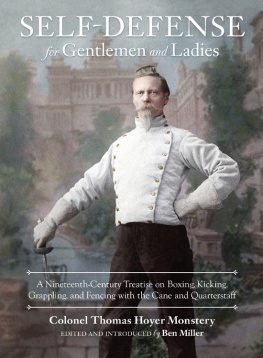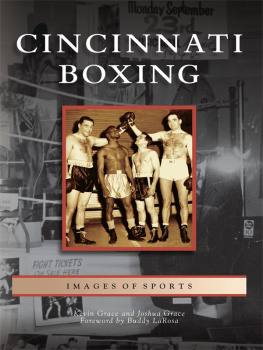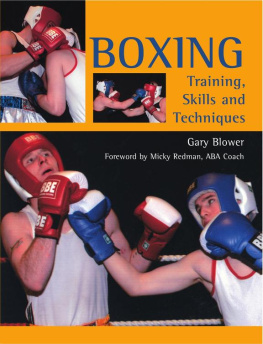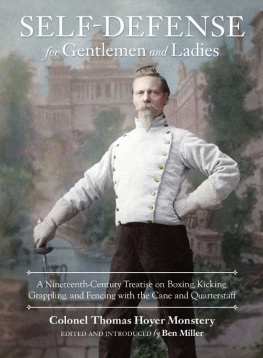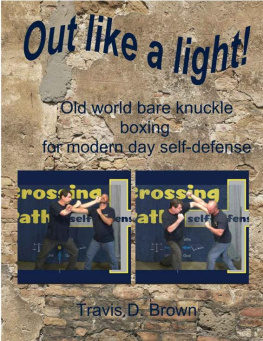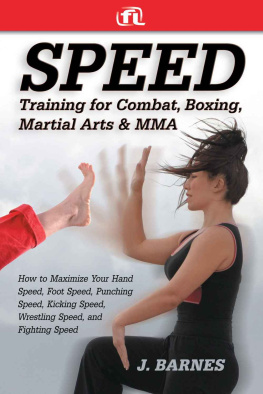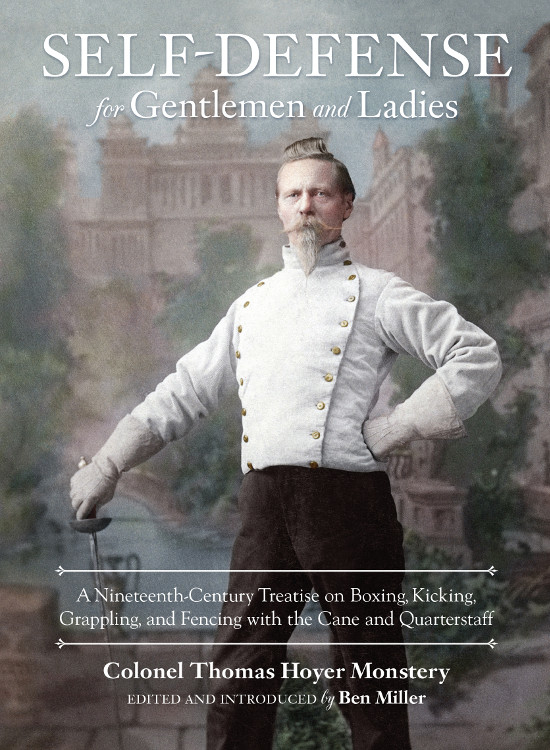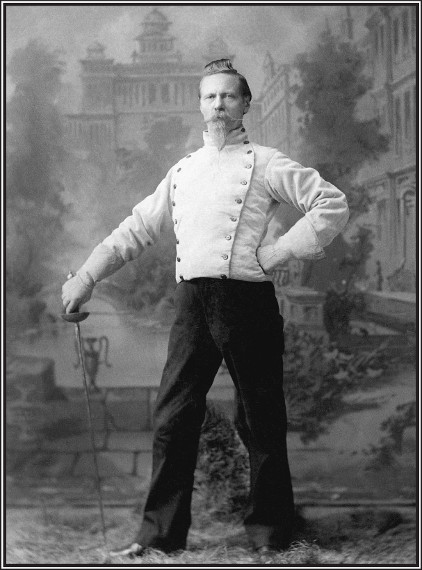Photograph signed Col. Thos. H. Monstery, May 2, 1885. Courtesy of Hargrett Rare Book and Manuscript Library / University of Georgia Libraries.
SELF-DEFENSE for Gentlemen and Ladies
A Nineteenth-Century Treatise on Boxing, Kicking, Grappling, and Fencing with the Cane and Quarterstaff
Colonel Thomas Hoyer Monstery
Edited and Introduced by Ben Miller

BLUE SNAKE BOOKS
BERKELEY, CALIFORNIA
Copyright 2015 by Ben Miller. All rights reserved. No portion of this book, except for brief review, may be reproduced, stored in a retrieval system, or transmitted in any form or by any meanselectronic, mechanical, photocopying, recording, or otherwisewithout written permission of the publisher. For information contact Blue Snake Books c/o North Atlantic Books.
Published by Blue Snake Books, an imprint of North Atlantic Books
P.O. Box 12327
Berkeley, California 94712
Cover photo of Thomas H. Monstery courtesy of Hargrett Rare Book and Manuscript Library / University of Georgia Libraries
Cover art by Bronwyn Frazier-Miller
Cover and book design by Brad Greene
Self-Defense for Gentlemen and Ladies: A Nineteenth-Century Treatise on Boxing, Kicking, Grappling, and Fencing with the Cane and Quarterstaff is sponsored and published by The Society for the Study of Native Arts and Sciences (dba North Atlantic Books), an educational nonprofit based in Berkeley, California, that collaborates with partners to develop cross-cultural perspectives, nurture holistic views of art, science, the humanities, and healing, and seed personal and global transformation by publishing work on the relationship of body, spirit, and nature.
North Atlantic Books publications are available through most bookstores. For further information, call 800-733-3000 or visit our websites at www.northatlanticbooks.com and www.bluesnakebooks.com.
PLEASE NOTE: The creators and publishers of this book are not and will not be responsible, in any way whatsoever, for any improper use made by anyone of the information contained in this book. All use of the aforementioned information must be made in accordance with what is permitted by law, and any damage liable to be caused as a result thereof will be the exclusive responsibility of the user. In addition, he or she must adhere strictly to the safety rules contained in the book, both in training and in actual implementation of the information presented herein. This book is intended for use in conjunction with ongoing lessons and personal training with an authorized expert. It is not a substitute for formal training. It is the sole responsibility of every person planning to train in the techniques described in this book to consult a licensed physician in order to obtain complete medical information on his or her personal ability and limitations. The instructions and advice printed in this book are not in any way intended as a substitute for medical, mental, or emotional counseling with a licensed physician or health-care provider.
Library of Congress Cataloging-in-Publication Data
Monstery, Thomas Hoyer, 1824-1901.
Self-Defense for gentlemen and ladies : a nineteenth-century treatise on boxing, kicking, grappling, and fencing with the cane and quarterstaff / Colonel Thomas Hoyer Monstery ; edited and introduced by Ben Miller.
pages cm
ISBN 978-1-58394-868-2 (Hard Cover) ISBN 978-1-58394-869-9 (E-book)
1. Self-defense. 2. Self-defense for women. 3. Martial arts weapons. 4. Martial artsHistory19th century. I. Miller, Ben, 1977- II. Title.
GV1111.M58 2015
613.66dc23
2014035215
Contents
PART ONE:
Colonel Thomas Hoyer Monstery: The Unknown American Martial Arts Master
PART TWO:
Self-Defense for Gentlemen and Ladies
I first learned of the great duelist and fencing master Thomas Hoyer Monstery several years ago, while researching ancient systems of European fencing and the various masters who taught them. That journey began in June of 2005, the day I first walked into the Martinez Academy of Arms in New York City.
I had been searching for a new martial art to begin training in, and the Academy was the fourth or fifth place on my list of schools to visit. Previously, I had studied Krav Maga and western boxing in New York, and Arnis stick fighting while living in the Philippinesall under notable instructors for whom I had great respect and admiration. And yet, I somehow felt unfulfilled in these martial arts. What, exactly, was missing, I did not know. But I was fairly certain that I would recognize it when I saw it.
I had never been interested in modern Olympic sport fencing, the purpose of which seemed to be about scoring points and winning at a game, rather than defending oneself in an actual combative situation. Whatever swordsmanship had been like hundreds of years ago, my reasoning and intuition told me that it little resembled what was now practiced on the Olympic strip. I had been told, however, that a different type of fencing was being practiced at the Martinez Academy in New York Cityone with a martial mind-set. It seemed incumbent upon me to at least witness what was being practiced there.
What I found there was something far more extraordinary and significant: a surviving tradition of the older, martial styles of European swordsmanshipone of the last traditions in the world, in fact. Not only were the objective, mind-set, and form completely different, but the various systems taught at the Academy included a vast, almost countless number of techniques that had completely vanished from the modern sport. Additionally, the usage of ancient European weapons such as the rapier, sword and dagger, single dagger, cloak, staff, cane, military saber, and others were being taught. The Academy was run by Maestro Ramn Martnez and Maestro Jeannette Acosta-Martnez, the former having been taught these systems and techniques by his own master, Matre dArmes Frederick Rohdes. A German born in 1897, and a veteran of at least one actual combat encounter with sharp broadswords, Rohdes had learned a variety of historical systems from his master, Marcel Cabijos, and others in Europe. Cabijos, a Frenchman and veteran of the First World War, had in 1926 notably defeated the pe and saber champion of the United States, Leo Nunes, with only a twelve-inch dagger.
In an age when Asian fighting systems had become synonymous with the term martial arts, here was a rare, surviving vestige of Western heritage, a culturally fundamental art that had roots stretching back nearly a thousand years, and which I saw being executed with great control, finesse, speed, and precision. Whatever magic I had been looking for, I had found it at the Martinez Academy.
As I began training, I was surprised to learn that other fencing enthusiasts outside of the Academy, or at least those of my own generation, were completely unaware that any older, martial traditions had survived. This was understandable, considering that nearly all modern books and references on the subject of fencing said not a word about older surviving styles. These texts presumed either that the modern sport of fencing was no different than the fencing of past centuries, or that the older traditions had become utterly extinct. Maestro Martnez told me that Master Rohdes had assured him that the old systems, including the use of antiquated weapons, had endured in certain fencing schools scattered across Europe, having been passed down through the ages from master to student. If Rohdes was correctand I had no reason to doubt that he wasthen, I reasoned, some record of these masters and their techniques must have survived as well. The question I posed to myself was, could such evidence be found? If so, modern references would be of little or no use. It would be necessary to delve into rare, highly obscure period sources.

